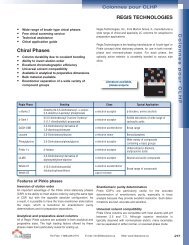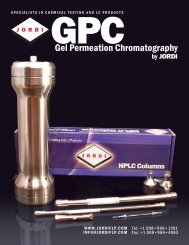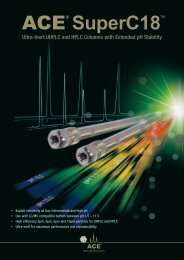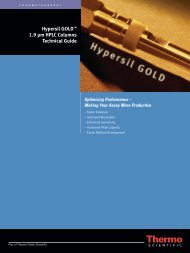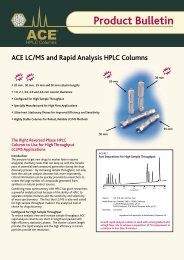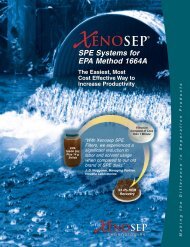Fused-Core⢠Particles for Very Fast HPLC Separations
Fused-Core⢠Particles for Very Fast HPLC Separations
Fused-Core⢠Particles for Very Fast HPLC Separations
You also want an ePaper? Increase the reach of your titles
YUMPU automatically turns print PDFs into web optimized ePapers that Google loves.
GUIDE TO ULTRA-FAST <strong>HPLC</strong><br />
Quick Tips <strong>for</strong> Converting<br />
Conventional Reversed-Phase<br />
<strong>HPLC</strong> <strong>Separations</strong><br />
to Ultra-<strong>Fast</strong> <strong>Separations</strong>
GUIDE TO ULTRA-FAST <strong>HPLC</strong><br />
Quick Tips <strong>for</strong> Converting<br />
Conventional Reversed-Phase<br />
<strong>HPLC</strong> <strong>Separations</strong><br />
to Ultra-<strong>Fast</strong> <strong>Separations</strong><br />
T<br />
here has been enormous interest recently in so-called “ultra-fast”<br />
<strong>HPLC</strong> columns that can reduce run times by 70% or more. These<br />
ultra-fast columns are typically packed with particles considerably<br />
smaller than what is packed in conventional columns, giving them the<br />
advantage of equivalent separating power in much shorter length columns<br />
as well as the advantage that they maintain their separating power at higher<br />
mobile phase flow rates. The ability to use shorter columns and higher<br />
flow rates offers an opportunity to reduce analysis time and increase sample<br />
throughput significantly by substituting an ultra-fast column <strong>for</strong> a<br />
conventional column in an established method.<br />
To facilitate converting conventional reversed-phase separations to ultrafast<br />
separations, we have created this quick tips guide. It is intended to<br />
assist you in selecting an ultra-fast column and modifying conditions <strong>for</strong> a<br />
faster run time. In addition, this guide will help you estimate how the new<br />
ultra-fast conditions will affect run time, resolution, and back pressure.<br />
First, one qualification: An important chromatographic parameter that<br />
seems to be ignored in most discussions of ultra-fast <strong>HPLC</strong> is selectivity.<br />
Although selectivity is beyond the scope of this guide, you should be aware<br />
that converting from a conventional column to an ultra-fast column will<br />
sometimes be accompanied by a change in selectivity <strong>for</strong> one or more peak<br />
pairs in your chromatogram. This may be true if you continue to use the<br />
same bonded phase chemistry, such as C18, and even true if the ultra-fast<br />
column you choose is the same brand as the conventional column that it<br />
is replacing. However, in most cases the change in selectivity will be minor<br />
enough that the estimation models used in this guide will still be useful.<br />
— 1 —
Suggested Steps <strong>for</strong> Converting a<br />
Conventional Reversed-Phase Separation<br />
to an Ultra-<strong>Fast</strong> Separation<br />
1. Select the shortest ultra-fast column that can provide resolution<br />
equivalent to or better than the conventional column. See Figure A.<br />
2. Estimate the back pressure <strong>for</strong> the selected “ultra-fast” column. See<br />
Figure B. If the pressure exceeds the maximum acceptable pressure <strong>for</strong><br />
your system, select an alternate column with lower back pressure, most<br />
likely one packed with larger particles. You could elect to operate at a<br />
lower flow rate to keep the pressure acceptable, but this would also<br />
increase the run time, negating the purpose of converting to an ultrafast<br />
column.<br />
Figure A: Resolving Power as a Function of Particle Size and Column Length<br />
Instructions: This chart plots Resolving Power (the ability of a column to separate<br />
components in a mixture) versus column length <strong>for</strong> 7 different columns. Three of<br />
the columns are packed with conventional particles (5.0 μm, 3.5 μm, and 3.0 μm)<br />
and four are packed with ultra-fast particles (2.2 μm, 2.7 μm <strong>Fused</strong>-Core ® , 1.8 μm,<br />
and 1.7 μm). As column length increases, so does Resolving Power, but run time<br />
also increases. Notice that the ultra-fast columns provide greater Resolving Power<br />
in much shorter column lengths compared to the conventional columns. When<br />
converting a conventional separation to an ultra-fast separation, choose the shortest<br />
ultra-fast column that provides Resolving Power equal to or better than the<br />
conventional column it is replacing. This will allow you to minimize run time and<br />
maintain acceptable resolution.<br />
1.7 μm<br />
1.8 μm<br />
2.7 μm <strong>Fused</strong>-Core<br />
2.2 μm<br />
3.0 μm<br />
3.5 μm<br />
Figure B: Relative Back Pressure versus Particle Size<br />
Instructions: For the ultra-fast column configuration selected in Step 1 (length,<br />
particle size), estimate the expected back pressure on this column by multiplying the<br />
pressure observed on the conventional column by the ratio of the “Relative<br />
Pressure” of the ultra-fast column to the conventional column and then by the ratio<br />
of the column lengths.<br />
Note: This calculation assumes that the mobile phase velocity is the same <strong>for</strong> both the<br />
conventional column and the ultra-fast column.<br />
P 2 = P 1 x<br />
RP 2 L<br />
x 2<br />
RP 1<br />
L 1<br />
P 2 : Estimated back pressure of the<br />
ultra-fast column<br />
RP 2 : Relative back pressure of the<br />
ultra-fast column<br />
L 2 : Length of the ultra-fast column<br />
P 1 : Measured back pressure of<br />
conventional column<br />
RP 1 : Relative back pressure of the<br />
conventional column<br />
L 1 : Length of the conventional column<br />
RESOLVING POWER<br />
5.0 μm<br />
PARTICLE SIZE<br />
1.7 μm 8.7<br />
1.8 μm<br />
7.7<br />
2.2 μm<br />
5.2<br />
2.7 μm <strong>Fused</strong>-Core<br />
3.4<br />
3 μm<br />
2.8<br />
3.5 μm 2<br />
0<br />
50 100 150 200 250<br />
COLUMN LENGTH (mm)<br />
5 μm 1<br />
0 2 4 6 8 10<br />
RELATIVE BACK PRESSURE<br />
Example: A 100 mm ultra-fast column packed with 2.7 μm <strong>Fused</strong>-Core particles<br />
meets the criteria of providing equal or better Resolving Power compared to a<br />
250 mm column packed with conventional 5 μm particles. This ultra-fast column is<br />
an appropriate choice <strong>for</strong> replacing the 250 mm length conventional column in an<br />
ultra-fast method.<br />
Example: A 100 mm ultra-fast column packed with 1.8 μm particles will generate<br />
approximately 3 times the back pressure of a 250 mm conventional column packed<br />
with 5 μm particles.<br />
7.7 100 mm<br />
P ULTRA-FAST COLUMN<br />
= P 1<br />
x x = 3.08 x P<br />
1 250 mm<br />
CONVENTIONAL COLUMN<br />
— 2 —<br />
— 3 —
3. Confirm that the selectivity and resolution of the ultra-fast column is<br />
adequate. Since the selectivity of the ultra-fast column may be different<br />
from the selectivity of the conventional column (this may be true even<br />
if both the conventional column and the ultra-fast column are the same<br />
brand), run your separation with the ultra-fast column and calculate<br />
resolution. If the resolution does not meet the minimum required<br />
resolution, you may have to choose a longer column, or possibly even<br />
a different brand of ultra-fast column (with a different selectivity) to<br />
achieve acceptable resolution. If the resolution exceeds the required<br />
resolution, you may be able to use an even shorter ultra-fast column, or<br />
at least operate at a higher mobile phase flow rate to reduce the run time<br />
even further.<br />
4. Once a column has been selected that provides acceptable resolution<br />
and pressure, increase the flow rate to minimize the run time while<br />
maintaining acceptable resolution and pressure. Considerable time<br />
savings and greater sample throughput can be achieved by operating at<br />
higher flow rates with an ultra-fast column, as long as you don’t exceed<br />
your system’s maximum back pressure. See Figure C.<br />
Figure C: Resolution versus Mobile Phase Flow Rate<br />
Instructions: : If the resolution on the selected ultra-fast column exceeds the<br />
minimum required resolution <strong>for</strong> the separation and does not exceed the pressure<br />
limit, you will be able to reduce analysis time further by increasing the flow rate.<br />
Since the optimum flow velocity (<strong>for</strong> maximum resolution) of an ultra-fast column is<br />
3 to 4 times faster than <strong>for</strong> a conventional column, you may actually be able to both<br />
reduce the run time and increase resolution by operating at a higher flow rate.<br />
This chart estimates change in resolution with changes in mobile phase velocity.<br />
Not only do ultra-fast columns have their optimum efficiency at higher mobile phase<br />
velocities, they also sacrifice less of their efficiency as mobile phase velocity is<br />
increased beyond their optimum.<br />
LOSS IN RESOLUTION<br />
20%<br />
15%<br />
10%<br />
5%<br />
Change in Resolution with Flow Rate<br />
5.0 μm<br />
2.7 μm <strong>Fused</strong>-Core<br />
3.5 μm<br />
3 μm<br />
2.2 μm<br />
1.8 μm<br />
1.7 μm<br />
0%<br />
0.1 0.2 0.3 0.4 0.5 0.6 0.7 0.8 0.9 1.0<br />
FLOW VELOCITY (cm/sec.)<br />
Example: An ultra-fast column packed with 2.7 μm <strong>Fused</strong>-Core particles can be<br />
operated at a relatively fast mobile phase velocity of 0.7 cm/sec and still retain over<br />
96% of its resolving power. A conventional column packed with 5 μm particles run<br />
at the same flow velocity would retain only about 82% of its resolving power.<br />
Converting Mobile Phase Velocity (cm/sec) to Column Flow Rate (ml/min)<br />
Mobile<br />
Phase<br />
Velocity<br />
Column ID (mm)<br />
1.0 2.1 3.0 4.6<br />
0.1 0.030 0.13 0.27 0.63<br />
0.2 0.059 0.26 0.53 1.3<br />
0.3 0.089 0.39 0.80 1.9<br />
0.4 0.12 0.52 1.1 2.5<br />
0.5 0.15 0.65 1.3 3.1<br />
Mobile<br />
Phase<br />
Velocity<br />
Column ID (mm)<br />
1.0 2.1 3.0 4.6<br />
0.6 0.18 0.79 1.6 3.8<br />
0.7 0.21 0.92 1.9 4.4<br />
0.8 0.24 1.0 2.1 5.0<br />
0.9 0.27 1.2 2.4 5.7<br />
1.0 0.30 1.3 2.7 6.3<br />
— 4 —<br />
— 5 —
5. If the separation uses gradient elution, you will need to adjust the<br />
gradient time (t G<br />
) to the volume of the ultra-fast column and <strong>for</strong> any<br />
changes in flow rate. See Figure D.<br />
6. Adjust the injection volume to the ultra-fast<br />
column’s volume. See Figure E.<br />
Figure D: Adjusting Gradient Time (t G<br />
) <strong>for</strong> Changes in Column Volume and<br />
Flow Rate<br />
Figure E: Adjust Sample Injection Volume <strong>for</strong><br />
Changes in Column Dimension<br />
t G2<br />
= t G1<br />
x<br />
V m2<br />
x F 1<br />
V m1<br />
F 2<br />
t G2 : Gradient time <strong>for</strong> the ultra-fast<br />
separation<br />
V m2 : Column volume of the ultra-fast<br />
column (see Table 1)<br />
F 2 : Flow rate <strong>for</strong> the ultra-fast<br />
separation<br />
t G1 : Gradient time <strong>for</strong> the<br />
conventional separation<br />
V m1 : Column volume of the<br />
conventional column (see Table 1)<br />
F 1 : Flow rate <strong>for</strong> the conventional<br />
separation<br />
S v2<br />
= S v1<br />
x V m2<br />
V m1<br />
S v2 : Injected sample volume <strong>for</strong> the ultra-fast column<br />
S v1 :<br />
Injected sample volume <strong>for</strong> the conventional<br />
column<br />
V m2 : Volume of the ultra-fast column (see Table 1)<br />
See Table on page 12 <strong>for</strong> estimates of column volumes <strong>for</strong> most commercially<br />
available column dimensions.<br />
Important Note: The system dwell volume (gradient mixing volume) can have a<br />
significant effect on the chromatography when using gradients because it adds an<br />
isocratic hold to the beginning of the gradient. The time of this “hold” is equal to the<br />
dwell volume divided by the flow rate. When the flow rate is changed, this isocratic<br />
hold will also change. This change in gradient hold will generally have more of an<br />
effect on early eluting peaks, but it will also affect all peaks in the chromatogram to<br />
some extent. To minimize the effect on your separation, keep the dwell volume as<br />
small as possible by using micro gradient mixers and keeping the tubing volume in<br />
the system to a minimum.<br />
V m1 : Volume of the conventional column (see Table 1)<br />
Example: A conventional method uses a sample<br />
injection volume of 20 μl on a column 4.6 x 150 mm.<br />
The sample volume that should be injected on to a<br />
4.6 x 50 mm ultra-fast column (2.7 μm <strong>Fused</strong>-Core) is:<br />
S v ULTRA-FAST<br />
= 20 μl x<br />
0.42 ml<br />
1.57 ml<br />
= 5 μl<br />
Example: A conventional method uses a column 4.6 x 150 mm (1.57 ml), a flow rate<br />
of 1.0 ml/min, and a gradient of 15% B to 35% B in 20.0 minutes. The gradient time<br />
<strong>for</strong> an ultra-fast method that uses a column 4.6 x 50 mm (2.7 μm <strong>Fused</strong>-Core,<br />
0.42 ml) and a flow rate of 2.0 ml/min is:<br />
t = 20 minutes x 0.42ml 1.0ml/min<br />
G ULTRA-FAST 1.57ml<br />
x 2.0ml/min<br />
= 2.7 min.<br />
— 6 —<br />
— 7 —
An Example of Converting a Conventional<br />
Separation to an Ultra-<strong>Fast</strong> Separation.<br />
Conventional <strong>HPLC</strong> Separation Conditions<br />
COLUMN: 4.6 x 250 mm, 5 μm<br />
FLOW RATE: 1.5 ml/min<br />
MOBILE PHASE: Isocratic<br />
RUN TIME: 10 minutes<br />
PRESSURE: 1,580 psi, 109 bar<br />
Maximum acceptable pressure = 4,000 psi, 275 bar<br />
RESOLUTION: 3.0<br />
SAMPLE INJECTION VOLUME: 20 μl<br />
Converting to Ultra-<strong>Fast</strong> Separation Conditions<br />
1. Select the shortest ultra-fast column that provides resolution<br />
equivalent to or better than the conventional column. (See Relative<br />
Resolution chart in Figure A.)<br />
A column 4.6 x 100 mm packed with 1.7 μm particles is selected<br />
<strong>for</strong> further investigation.<br />
2. Estimate back pressure. (See relative pressure table in Figure B.)<br />
8.7 100 mm<br />
P Ultra-<strong>Fast</strong> Column<br />
= 1,580 psi x x = 5,498 psi<br />
1 250 mm<br />
Since this ultra-fast column exceeds our maximum acceptable<br />
back pressure (4,000 psi), a different ultra-fast column is selected<br />
<strong>for</strong> investigation.<br />
The alternative ultra-fast column selected is a 4.6 x 100 mm packed<br />
with 2.7 μm <strong>Fused</strong>-Core particles (HALO <strong>HPLC</strong> column). The<br />
back pressure on this column is:<br />
3.4 100 mm<br />
P Ultra-<strong>Fast</strong> Column<br />
= 1,580 psi x x = 2,149 psi<br />
1 250 mm<br />
This ultra-fast column provides both acceptable resolution and<br />
acceptable back pressure <strong>for</strong> our method.<br />
3. Confirm that the selectivity and resolution of the ultra-fast column<br />
is adequate.<br />
For simplicity, we will assume that the selectivity of this ultra-fast<br />
column is almost identical to the selectivity of the conventional<br />
column and, there<strong>for</strong>e, the resolution is adequate.<br />
4. Optimize flow rate to minimize run time. (See Figure C to estimate<br />
changes in resolution with changes in flow rate.)<br />
We can further reduce run time by operating the ultra-fast<br />
column at a higher flow rate. We just have to make sure we stay<br />
within the requirements of minimum resolution and maximum<br />
pressure. The ultra-fast column we selected has low enough back<br />
pressure that we can operate at a flow rate of 2.5 ml/min and still<br />
stay within our defined limits of pressure and resolution.<br />
P at 2.5 ml/min<br />
= 2,149 psi x<br />
5. Adjust the gradient time.<br />
This is an isocratic separation, so no adjustment to gradient time<br />
is required.<br />
6. Adjust the injection volume. (See Figure D <strong>for</strong> calculations and table<br />
with estimated column volumes.)<br />
Sample volume =20 μl x<br />
Ultra-<strong>Fast</strong> Conditions<br />
2.5 ml/min<br />
1.5 ml/min<br />
0.84 ml<br />
2.62 ml<br />
= 3,582 psi<br />
= 6.4μl<br />
COLUMN: 4.6 x 100 mm, 2.7 μm <strong>Fused</strong>-Core (HALO®)<br />
FLOW RATE: 2.5 ml/min<br />
RUN TIME: 0.84 ml 1.5 ml/min<br />
10 min x x = 1.9 min*<br />
2.62 ml 2.5 ml/min<br />
RESOLUTION: 3.1<br />
PRESSURE: 3,582 psi<br />
SAMPLE INJECTION VOLUME: 6.4 μl<br />
* Run time <strong>for</strong> the ultra-fast separation can be estimated by multiplying the run time on the conventional column by the<br />
ratio of the volumes of ultra-fast column to the conventional column and then by the inverse ratio of the flow rates on<br />
the two columns. (See page 12)<br />
— 8 —<br />
— 9 —
Conventional Separation<br />
COLUMN: 4.6 x 250 mm, 5 μm, C18<br />
FLOW RATE: 1.5 ml/min<br />
RESOLUTION: 3.0<br />
PRESSURE: 1,580 psi<br />
RUN TIME: 10 minutes<br />
SAMPLE INJECTION VOLUME: 20 μl<br />
Ultra-<strong>Fast</strong> Separation<br />
COLUMN: 4.6 x 100 mm, 2.7 μm <strong>Fused</strong>-Core, C18 (HALO® <strong>HPLC</strong> column)<br />
FLOW RATE: 2.5 ml/min<br />
RESOLUTION: 3.1<br />
PRESSURE: 3,582 psi<br />
RUN TIME: 1.9 minutes<br />
SAMPLE INJECTION VOLUME: 6.4 μl<br />
Rs = 3.0<br />
Rs = 3.1<br />
0 2 4 6 8 10 12<br />
TIME (minutes)<br />
0 0.5 1.0 1.5 2.0 2.5<br />
TIME (minutes)<br />
These are simulated chromatograms generated from theoretical data. Differences in selectivity between<br />
a conventional column and an ultra-fast column or changes in secondary retention interactions will yield<br />
different chromatographic results from what is predicted here.<br />
— 10 —<br />
— 11 —
Reference Tables and Equations <strong>for</strong><br />
Quick Estimates<br />
Table 1: Estimated volume, V m , <strong>for</strong> a variety of available column dimensions<br />
ID<br />
(mm)<br />
Length<br />
(mm)<br />
V m<br />
(ml)<br />
V m <strong>Fused</strong>-Core<br />
(ml)<br />
ID<br />
(mm)<br />
Length<br />
(mm)<br />
V m<br />
(ml)<br />
V m <strong>Fused</strong>-Core<br />
(ml)<br />
1.0 20 0.010 0.008<br />
1.0 30 0.015 0.012<br />
1.0 50 0.025 0.020<br />
1.0 75 0.037 0.030<br />
1.0 100 0.050 0.040<br />
1.0 150 0.074 0.059<br />
1.0 250 0.124 0.099<br />
2.1 20 0.044 0.035<br />
2.1 30 0.066 0.052<br />
2.1 50 0.109 0.087<br />
2.1 75 0.164 0.131<br />
2.1 100 0.218 0.175<br />
2.1 150 0.327 0.262<br />
2.1 250 0.546 0.436<br />
3.0 20 0.089 0.071<br />
3.0 30 0.134 0.107<br />
3.0 50 0.223 0.178<br />
3.0 75 0.334 0.267<br />
3.0 100 0.445 0.356<br />
3.0 150 0.668 0.534<br />
3.0 250 1.11 0.89<br />
4.6 20 0.209 0.168<br />
4.6 30 0.314 0.251<br />
4.6 50 0.524 0.419<br />
4.6 75 0.785 0.628<br />
4.6 100 1.05 0.84<br />
4.6 150 1.57 1.26<br />
4.6 250 2.62 2.09<br />
Note: Column volumes listed here are estimates only. However, most commercial columns can be expected<br />
to have volumes within about 5% of what is reported here. Columns packed with <strong>Fused</strong>-Core particles are an<br />
exception and, there<strong>for</strong>e, are listed separately.<br />
Table 2: Column plate number, N, <strong>for</strong> columns packed with different size/type particles<br />
Not like other<br />
ultra-fast<br />
<strong>HPLC</strong> columns.<br />
Particle<br />
N per cm of column length<br />
Particle<br />
N per cm of column length<br />
5 μm<br />
3.5 μm<br />
3 μm<br />
2.2 μm<br />
800<br />
1140<br />
1330<br />
1800<br />
2.7 μm <strong>Fused</strong>-Core<br />
1.8 μm<br />
1.7 μm<br />
2200<br />
2220<br />
2300<br />
Note: Estimates in this Table are <strong>for</strong> near ideal conditions. Column plate number is dependent on many factors<br />
including the solute, mobile phase viscosity and flow velocity and it is not unusual under “real-world” conditions<br />
<strong>for</strong> column plate numbers to be over 20% lower than what is reported here.<br />
Estimating changes in run time with changes in column volume and flow rate<br />
RT ultra-fast<br />
= RT conventional<br />
x<br />
V ultra-fast<br />
V conventional<br />
RT = Run Time<br />
V = Column Volume<br />
F = Flow rate (If column ID changes, mobile phase velocity should be used instead of flow rate.)<br />
Estimating changes in Resolution with changes in column plate number<br />
x<br />
F ultra-fast<br />
F conventional<br />
HALO <strong>HPLC</strong> columns made with <strong>Fused</strong>-Core ® particle technology<br />
are hyper-fast and super-rugged. Their low back pressure allows<br />
them to be used with conventional <strong>HPLC</strong> equipment as well as<br />
ultra-high pressure systems.<br />
Rs ultra-fast<br />
= Rs conventional<br />
x<br />
N ultra-fast<br />
N conventional<br />
Rs = Resolution<br />
N = Column plate number<br />
HALO columns can turn almost any <strong>HPLC</strong> into a<br />
high speed workhorse <strong>for</strong> your laboratory.<br />
— 12 — HALO and <strong>Fused</strong>-Core are registered trademarks of Advanced Materials Technology, Inc.
www.advanced-materials-tech.com<br />
LC489



